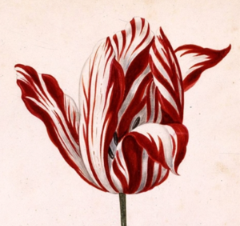Items
Site
The Medicine Chest
keywords is exactly
Tulipmania
-

The broken tulip
"During the period known as tulipmania which transpired in the Netherlands during the 17th century, contract prices for bulbs of the recently introduced tulip reached extraordinarily high levels and then suddenly collapsed. Tulips that displayed a break in their colour reached prices far higher than those that didn’t. It wasn’t until 1920, after the invention of the electron microscope, that scientists discovered that the cause for this symphony of colour was a virus that spread from tulip to tulip by Myzus persicae, the peach potato aphid. Michael Pollan in The Botany of Desire, explains this phenomenon: “The colour of a tulip consists of two pigments working in concert — a base colour that is always yellow or white and a second, laid-on colour called an anthocyanin; the mix of these two hues determining the unitary colour we see. The virus works by partially and irregularly suppressing the anthocyanin, thereby allowing a portion of the underlying colour to show through — creating the magic of the broken tulip. A fact that, as soon as it was discovered, doomed the beauty it had made possible" (Pollan 2003: 97 in Liebenberg 2011: 92). -

Semper Augustus Tulip
Photo of Semper Augustus watercolour, captured whilst perusing the Pera Museum, Istanbul, 2013 -

Tobacco Mosaic Virus
During the late 19th century, tobacco farmers observed a strange occurrence on the leaves of their tobacco plants. A mosaic pattern of light and dark green (or yellow and green, in some instances) appeared on the leaves of their crops, the presence of which signalled the steady decline in the plant’s growth. Because of the lucrative nature of the industry, finding a treatment for this seemingly infectious disease became a priority, with many laboratories working to isolate the cause. Bacteria were recognised as the causative agents of many infectious diseases of plants and animals, including humans, in the second half of the 19th century – and the technique of filtration was developed to separate infectious agents from extracts or exudates in order to study these microbes. It was whilst utilising this technique that Dmitri Ivanovski, a Russian microbiologist working in the Crimea in 1890, made a surprising discovery. Using the Chamberland–filter made from porcelain and designed to trap ordinary bacteria, Ivanovsky discovered that the filtered sap from the diseased plants could continue to transfer the infection to healthy plants – an occurrence he attributed to an agent which must be an exceedingly small parasitic microorganism, invisible even under great magnification. It would take another 45 years before the visualisation of this subcellular entity would be formulated with the help of an electron microscope, but Ivanovksy, along with the Dutch botanist M.W. Beijerinck, who also and independently, isolated these microbes in his laboratory in 1898, are generally credited for the discovery of viruses. The disease which infected the tobacco plants would be aptly called the Tobacco Mosaic Virus, and its identification would signal the initiation of a field of study known as virology.


